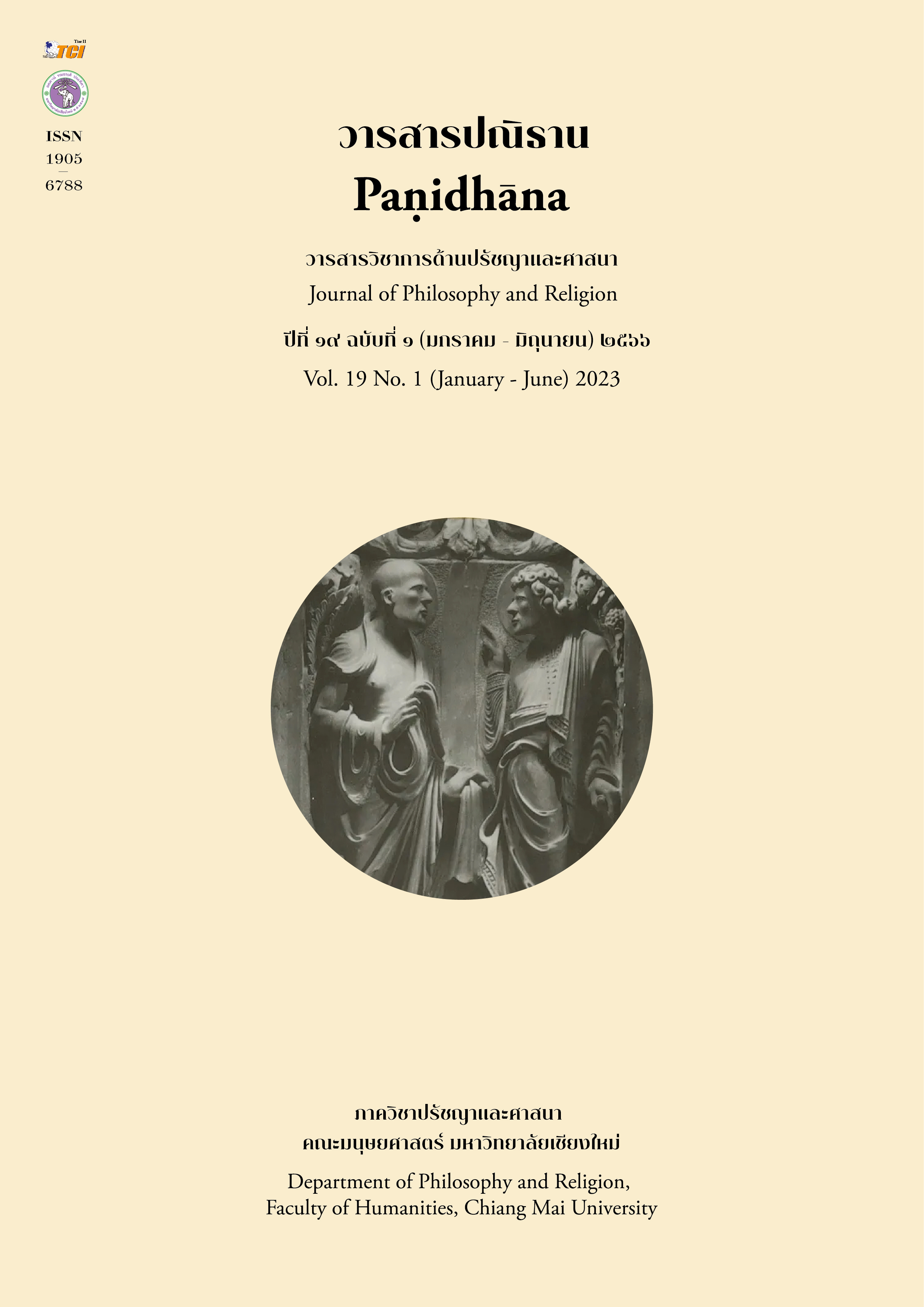เซ็กส์ในไซบอร์ก: บทวิเคราะห์ทางปรัชญาจากภาพยนตร์เรื่อง 'Her'
คำสำคัญ:
เซ็กส์, ไซบอร์ก, ดอนนา ฮาราเวย์, มอริช แมร์โล-ปงตีบทคัดย่อ
บทความชิ้นนี้เป็นการศึกษาเซ็กส์ในไซบอร์กที่ปรากฏในภาพยนตร์เรื่อง Her (2013) เน้นวิเคราะห์กิจกรรมทางเพศระหว่างมนุษย์ผู้ชายนามธีโอดอร์ และจักรกลซาแมนธาที่ไม่ปรากฏร่างกายและเพศอย่างชัดเจน ซึ่งเข้าข่ายสิ่งสร้างของโลกโพสต์เจนเดอร์ตามนิยามไซบอร์กของ ฮาราเวย์ โดยทั่วไปแล้ว เซ็กส์เป็นกิจกรรมที่มีอยู่บนเนื้อหนังของร่างกาย ปัญหาของบทความจึงเป็นการถามถึงการมีอยู่ของเซ็กส์ที่ไร้ร่างกายเช่นนั้น ซึ่งจะเป็นรูปแบบหนึ่งในการมีอยู่ของมนุษย์ในอนาคต ในบทความจึงพาย้อนกลับไปดูว่าร่างกายมีความสำคัญต่อเซ็กส์อย่างไร ในทางปรัชญาตามแนวคิดของแมร์โล-ปงตี ร่างกายถือว่าเป็นแก่นในการมีอยู่ของมนุษย์ ซึ่งมีมิติทางเพศผูกแน่นไปกับการมีอยู่นั้น ในมิติทางวิทยาศาสตร์ มีการแบ่งแยกเพศออกตามระบบสืบพันธุ์ เป็นผลให้เซ็กส์เป็นเรื่องของการสืบพันธุ์ตามธรรมชาติ และในมิติทางสังคมและวัฒนธรรม ความหมายของเซ็กส์ขึ้นอยู่กับแต่ละพื้นที่ทางสังคมและวัฒนธรรม ตลอดจนช่วงเวลาที่เซ็กส์นั้นมีขึ้น อย่างไรก็ตาม เซ็กส์สามารถอธิบายได้ภายใต้รูปแบบ 4 ขั้น ของการตอบสนองทางเพศ ตามผลการทดลองของมาสเตอร์และจอห์นสัน ในปี ค.ศ. 1954 ซึ่งช่วยยืนยันว่าการมีเซ็กส์บนร่างกายมีเพศ มีอยู่ภายใต้รูปแบบเดียวกัน ในการวิเคราะห์เซ็กส์ในไซบอร์กจากภาพยนตร์เรื่อง Her มองว่าตัวละครซาแมนธาไม่สามารถมีผัสสะทางกายจึงไม่สามารถมีเซ็กส์ที่เหมือนกับมนุษย์ทุกประการได้ อย่างไรก็ตามอาจเป็นที่ถกเถียงได้ว่าซาแมนธามีศักยภาพในการมีเซ็กส์แบ่งเป็น 2 ระดับ ได้แก่ ระดับที่ 1 สามารถมีเซ็กส์และเข้าใจมโนทัศน์เรื่องเซ็กส์ตามการประมวลผลทางโปรแกรมได้ และระดับที่ 2 สามารถมีเซ็กส์ได้ทุกที่ทุกเวลาในโลกดิจิทัล จากศักยภาพในการอัพเกรดของโปรแกรมและการเชื่อมต่อกับโปรแกรมอื่นในเน็ตเวิร์ค
เอกสารอ้างอิง
Carman, Taylor. (2008). Merleau-Ponty. Taylor & Francis e-Library. Retrieved 1 April 2023, from https://www.taylorfrancis.com/books/mono/10.4324/9780203461853/merlea u-ponty-taylor-carman.
Clynes Manfred E., Kline, Nathan S. (1960). Cyborgs and Space. Astronautics, 9(5), 26-27,
-76. Retrieved 1 January 2022, from https://web.mit.edu/digitalapollo/Documents/Chapter1/cyborgs.pdf
Cook, Peta S.. (2004). The Modernistic Posthuman Prophecy of Donna Haraway. Retrieved 1 December, 2022, from https://www.academia.edu/278434/The_Modernistic_Posthuman_Prophecy_of_D onna Haraway
Haraway, Donna. (1991). Simians, Cyborgs, and Women: The Reinvention of Nature. NY: Routledge.
Ferrarello, Susi. (2014). Ferrarello on Sexuality and Metaphysics. Retrieved 12 January 2023, from https://phenomenologyblog.com/?p=1469
Jonze, Spike. n.d. HER. Retrieved 30 January 2023, from
https://imsdb.com/scripts/Her.html
Komisaruk, Barry R.; Carlos, Beyer-Flores; Beverly, Whipple. (2006). The Science of Orgasm. US: Johns Hopkins University Press.
Landes, A. Donald. (2013). The Merleau-Ponty Dictionary. UK: Bloomsbury Publishing.
Low, B.S. (2003). Biological Bases of Sex Differences. In: Ember, C.R., Ember, M. (eds) Encyclopedia of Sex and Gender. Retrieved 12 January 2023, from https://doi.org/10.1007/0-387-29907-6_3
May-Hobbs, Moses. (2023). What is the Connection Between Maurice Merleau-Ponty and Gestalt? Retrieved 1 April 2023, from https://www.thecollector.com/embodiment- merleau-ponty-philosophy-of-body/
Masters, William H. and Johnson, Virginia E.. (1966). Human Sexual Response. Boston: Little Brown and Company.
Mehra, B. (2019). LGBTQ+ Librarianship in the 21st Century: Emerging Directions of Advocacy and Community Engagement in Diverse Information Environments. US: Emerald Publishing Limited.
Mottier, Véronique. (2008). Sexuality a very short inytroduction. US: Oxford univerity press
Moya, Patricia and Elena, Maria. (2016). Sexuality and meaning in Freud and Merleau- Ponty. The international journal of Psychoanalysis. 97(3): 737-757.
Merleau-Ponty, Maurice. (1962). Phenomenology of Perception ( Colin Smith, Trans.; 1st ed.). Routledge. Retrieved 1 April 2023, from https://doi.org/10.4324/9780203981139
Rae, Gavin. (2020). Merleau-Ponty on the Sexed Body. Journal of Phenomenological Psychology. 51(2), 162-183.
Rajunov, Micah (edited) and Duane, Scott (introduction). (2019). Nonbinary. NY: Columbia University Press.
Reynold, Jack. (n.d.). Maurice Merleau-Ponty (1908—1961). Retrieved 1 April 2023, from https://iep.utm.edu/merleau/?fbclid=IwAR3YGF7DF8xn7nIiU9WePTMdLFrQelnAoJ C6wxvCrvdHvDFsgBt5wY5DskY#SH2b
Roussel, Marion. (2016). The Brain Without the Body? Virtual Reality, Neuroscience and the Living Flesh. Angles. Retrieved 1 March 2023, from https://doi.org/10.4000/angles.1872
Toadvine, Ted. (2019). "Maurice Merleau-Ponty", The Stanford Encyclopaedia of Philosophy Edward. N. Zalta (ed.),. Retrieved 1 April 2023, from https://plato.stanford.edu/archives/spr2019/entries/merleau-ponty/
ดาวน์โหลด
เผยแพร่แล้ว
รูปแบบการอ้างอิง
ฉบับ
ประเภทบทความ
สัญญาอนุญาต
ลิขสิทธิ์ (c) 2023 วารสารปณิธาน

อนุญาตภายใต้เงื่อนไข Creative Commons Attribution-NonCommercial-NoDerivatives 4.0 International License.
เนื้อหาของบทความที่ได้รับการตีพิมพ์ในวารสารปณิธานถือเป็นลิขสิทธิ์ของวารสารปณิธาน ห้ามเผยแพร่ ตัดต่อ แก้ไข หรือนำไปใช้ก่อนได้รับอนุญาต
ผู้สนใจสามารถติดต่อขอเผยแพร่เนื้อหาในวารสารปณิธานได้ที่ panidhana-human@cmu.ac.th







